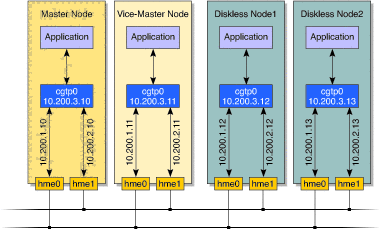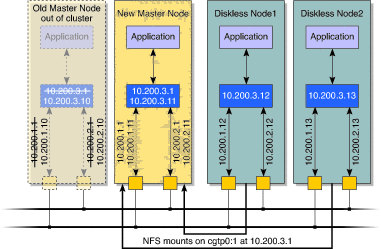| Netra™ High Availability Suite 3.0 1/08 Foundation Services Overview |
| C H A P T E R 4 |
For a description of the type of addressing that can be used within the private network of a Netra HA Suite Foundation services cluster, see the following sections:
Peer nodes communicate with each other over a private network called the cluster network.
The addressing scheme used by the cluster network is classless. The IP addresses of peer nodes can be in a private network or a public network. It is advantageous to configure a cluster in a private network for the following reasons:
All peer nodes are assigned IPv4 addresses. The address is split into a network part and a host part. The dividing point between the network part and the host part is defined by the netmask.
The following figure illustrates the structure of an IPv4 address on a peer node.

The network part of an IP address represents the identity of the network to which a peer node is connected. The host part of an IP address represents the nodeid of the peer node. The nodeid is the decimal equivalent of the host part of the IP address.
In a class B addressing scheme, the value of the netmask is ffff0000. The network part of an IP address is 16 bits long, and the host part of an IP address is 16 bits long.
In the class C addressing scheme, the value of the netmask is ffffff00. The network part of an IP address is 24 bits long, and the host part of an IP address is 8 bits long. By default, a class C address on a Netra HA Suite cluster has the following format:
10.domainid.interfaceid.nodeid
Netra HA Suite software can use a classless addressing scheme. The value of the netmask is not restricted to any address class.
The following values of the host part of the IP address are reserved:
Value 0 is reserved for the identification of the network part of the IP address.
Value 1 is reserved for the floating address triplet. For information about the floating address triplet, see Floating Address Triplet.
Value 2n-1 is reserved for the broadcast address. The parameter n is the number of bits in the host part of the IP address.
A node address triplet is assigned to each peer node in a cluster. The node address triplet consists of three IP addresses:
An IP address for each of the two physical interfaces, NIC0 and NIC1
An IP address for the virtual interface, called the CGTP address
The CGTP address is used for IP routing. It hides the multirouting capability of CGTP. The CGTP address presents the redundant network as a single network interface. Applications can use the CGTP address to communicate with the master node. The CGTP address supports unicast, broadcast, and multicast transmissions. For more information about CGTP, see Chapter 3.
The following table shows an example of node address triplets for a cluster containing two server (master and vice-master) nodes and two client (diskless) nodes. The cluster uses a default class C addressing scheme.
The following figure shows the address triplets of the preceding cluster.

In addition to a node address triplet, the master node and vice-master node have an address triplet called the floating address triplet. The floating address triplet is activated on the master node only. If the master node fails over or is switched over, the floating address triplet is activated on the new master node. It is deactivated on the old master node.
Diskless nodes and dataless nodes access services and data on the master node, through the floating address triplet. Because the floating address triplet is always up on the master node, the diskless nodes and dataless nodes can access the master node even after a failover or switchover.
The floating address triplet has a logical address. A logical address is an address that is assigned to a physical interface or virtual interface. A logical address for an hme0 or cgtp0 interface has the format hme0:x or cgtp0:x.
The following table shows an example of the node address triplet and floating address triplet of a master node. The cluster is using a default class C addressing scheme.
FIGURE 4-3 shows the node address triplet and floating address triplet of the master node and vice-master node. The diskless nodes are doing a Network File System (NFS) mount onto the master node through the floating address triplet. The floating address triplet of the vice-master node is crossed out because it is down.

FIGURE 4-4 shows the cluster in FIGURE 4-3 after a failover. The diskless nodes are still accessing their mounted partitions through the floating address triplet and on the new master node.

Copyright © 2008, Sun Microsystems, Inc. All rights reserved.